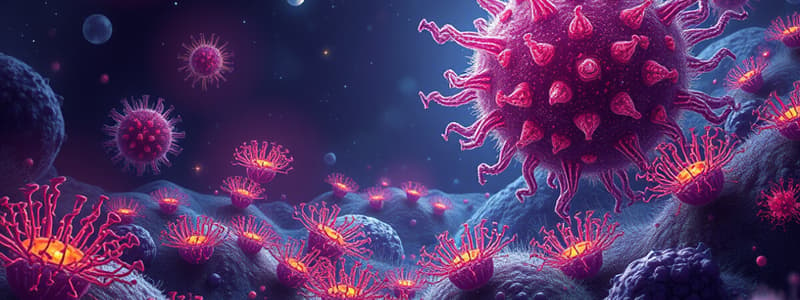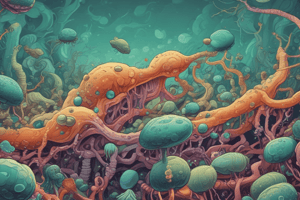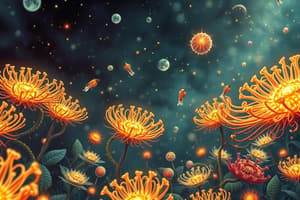Podcast
Questions and Answers
Name the 3 groups of the kingdom Protista and their characteristics.
Name the 3 groups of the kingdom Protista and their characteristics.
Algae, protozoa, slime molds.
Slime mold is unlike fungi.
Slime mold is unlike fungi.
True (A)
Describe protozoan locomotion by flagella and cilia.
Describe protozoan locomotion by flagella and cilia.
Protozoans move by flagella or cilia; flagella beat back and forth to push against water, similar to a fish's tail.
Describe protozoan locomotion by pseudopodia.
Describe protozoan locomotion by pseudopodia.
What role do algae play in general marine life?
What role do algae play in general marine life?
What are algal cells made of?
What are algal cells made of?
How do algae obtain and use sunlight?
How do algae obtain and use sunlight?
How are protozoans generally classified?
How are protozoans generally classified?
How are protozoan groups commonly identified?
How are protozoan groups commonly identified?
How do cellular and acellular slime molds differ?
How do cellular and acellular slime molds differ?
What is an acellular slime mold?
What is an acellular slime mold?
What are algae?
What are algae?
What are amoebas?
What are amoebas?
What is ATP?
What is ATP?
What is a cellular slime mold?
What is a cellular slime mold?
What is chlorophyll?
What is chlorophyll?
What are chloroplasts?
What are chloroplasts?
What are ciliates?
What are ciliates?
What is a cyst?
What is a cyst?
What are diatoms?
What are diatoms?
What are flagellates?
What are flagellates?
What is photosynthesis?
What is photosynthesis?
What is phytoplankton?
What is phytoplankton?
What is a plasmodium?
What is a plasmodium?
What are protists?
What are protists?
Flashcards are hidden until you start studying
Study Notes
Kingdom Protista Groups
- Three groups: Algae, Protozoa, Slime molds.
- Algae: Unicellular or form large structures like seaweed; vital in marine ecosystems.
- Protozoa: Unicellular, lack photosynthesis, utilize motility organs for movement and feeding.
- Slime molds: Decompose organic material, form spores similar to fungi.
Characteristics of Slime Molds
- Some slime molds possess flagella or pseudopodia, differentiating them from true fungi.
Protozoan Locomotion
- Flagellar movement: Protozoans use flagella that slide microtubules against each other, creating propulsion in water.
- Ciliary movement: Cilia beat in unison for motion and food movement towards the oral cavity.
- Pseudopodial movement: Extensions of cell membranes that attach to surfaces, allowing the cell to crawl.
Algae's Role in Marine Life
- Algae are crucial components of phytoplankton; fundamental for marine food chains.
- Phytoplankton generates more oxygen than Earth's forests.
Composition and Function of Algal Cells
- Cell walls are primarily made of cellulose, agar, and pectin.
- Algae contain chlorophyll in chloroplasts, enabling photosynthesis to convert sunlight into chemical energy.
Classification of Protozoans
- Protozoans categorized by locomotion:
- Flagellates: Flagella
- Pseudopods: Pseudopodia
- Ciliates: Cilia
- Sporozoites: No locomotion apparatus.
Identifying Protozoans
- Key identification criteria: locomotion apparatus, shape, size, number of nuclei, presence of cysts.
Cellular vs. Acellular Slime Molds
- Cellular slime molds consist of individual cells that cluster together.
- Acellular slime molds form a single multinucleated plasmodium.
Definitions and Key Concepts
- Acellular slime mold: Forms plasmodium.
- Algae: Typically unicellular; critical for phytoplankton; motile with flagella; cell walls of cellulose.
- Amoebas: Type of protozoan using pseudopodia for movement.
- ATP (adenosine triphosphate): Main energy source for cells.
- Chlorophyll: Pigment in algae responsible for photosynthesis, capturing sunlight for energy conversion.
- Chloroplasts: Organelles housing chlorophyll.
- Ciliates: Protozoans with cilia that aid in movement and feeding.
- Cysts: Dormant, resistant forms of protozoa, analogous to bacterial endospores.
- Diatoms: Algae with silica-based structures, creating sediment when they die.
- Flagellates: Protozoans with flagella for locomotion and feeding.
- Photosynthesis: Process converting sunlight into carbohydrates from CO2 and water.
- Phytoplankton: Free-floating plant-like organisms vital to oceanic ecosystems.
- Plasmodium: A cluster of fused cells in acellular slime molds.
- Protists: Diverse eukaryotic group excluding plants, animals, and fungi.
Studying That Suits You
Use AI to generate personalized quizzes and flashcards to suit your learning preferences.




